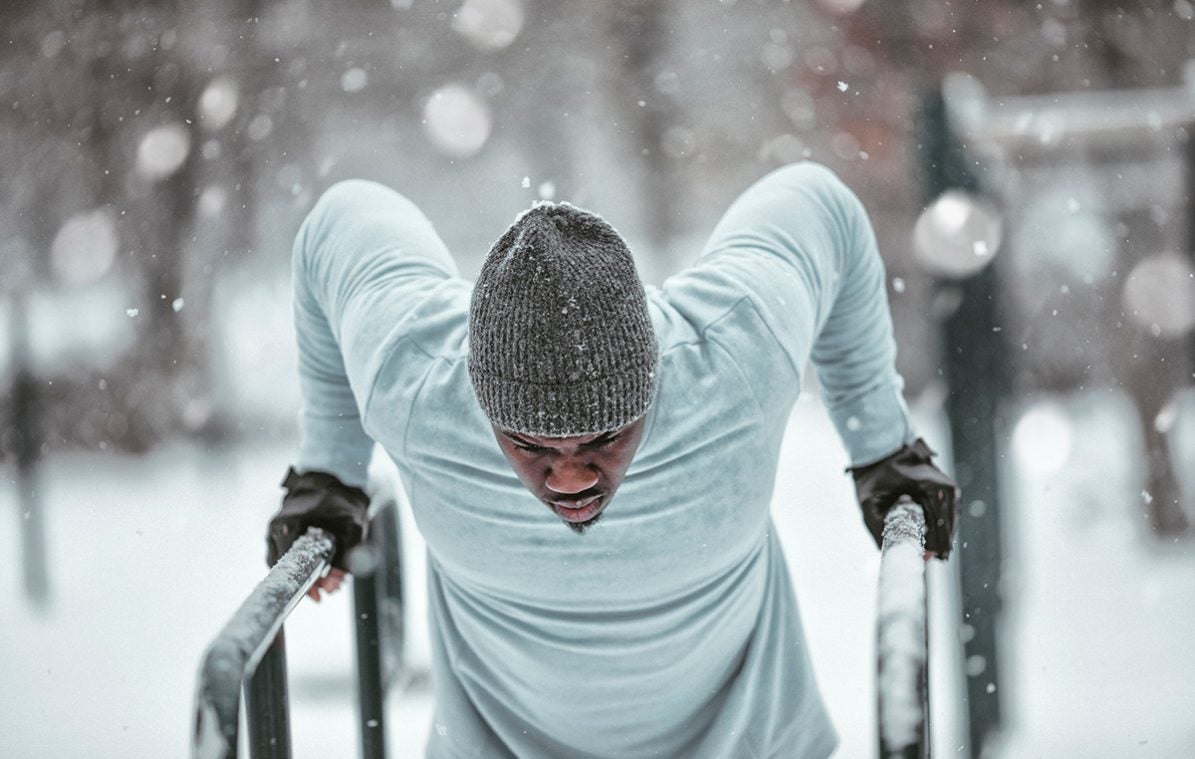5 Tips for Training Outdoors in Winter
 © foodspring
© foodspring
Many athletes who ski, snowboard, skate, or hike train outside in the winter. But HIIT fans are also often drawn to the outdoors, despite the cold temperatures. An outdoor workout during the winter strengthens the immune system, provides some variety, and helps the body get used to the temperature outside. This last point is a huge advantage, especially for a competition. To help you perform at your best despite the cold weather, we’ve prepared a few tips for your next outdoor workout.
Related: This workout will get you fit for winter sports.
#1 Focus on Carbohydrates
Before you start working out, you should eat a meal that has plenty of carbohydrates. According to a review published in the International Journal of Environmental Research and Public Health, glycogen stores should be at sufficiently high levels before attempting endurance sports in cold weather. And for that, you need carbohydrates. They give you energy: a lack of energy leads to a drop in performance. If your training is less intense, heat production will simultaneously decrease too, because your body isn’t working so hard, meaning your muscles produce less heat. The resulting heat loss could potentially lead to hypothermia if the outside temperature is low (below 15 degrees).
Sources of high-quality carbohydrates include whole-grain pasta, oatmeal topped with fruit, or wholegrain bread. Our protein porridge works well as a pre-workout breakfast and provides you with complex carbohydrates paired with protein. Our energy bars are perfect for when you’re on the go. They’ll give you readily available carbohydrates from oatmeal and plant-based syrup.
#2 Don’t Wear Too Much
One of the factors you have the most control over when exercising outdoors is your clothing. If you’re exercising in low temperatures, the European Journal of Applied Physiology recommends not wearing too much: you don’t want to be too warm when you start working out. Runners often dress as if it were 6 or 7 degrees warmer outside than it actually is. If you watch a marathon race in winter, you’ll notice that the first 10 kilometers are littered with long-sleeved t-shirts and discarded sweatpants (these are usually collected and donated by the race organizers). But let’s assume you’re not going to throw your clothes away on the side of the road. It’s best to wear breathable and moisture-wicking clothing to minimize sweating as much as possible. You should pay particular attention to your hands and feet. Get socks and gloves that are specifically made for winter sports. Your head and face should be protected with breathable and insulating fabric in sub-zero temperatures.
#3 Gradually Get Your Body Used to the Cold
Research suggests that acclimatizing to the cold reduces activation of your sympathetic nervous system, which may have a positive effect on performance. The sympathetic nervous system is a network of nerves that helps the body activate its “flight-or-fight” response. This system kicks in when you are stressed, in danger, or physically active. For you as an athlete, this means regularly training in the cold to get your body used to it, and experimenting with different combinations of clothing layers. For example, many cross-country skiers change their clothing base layer between warming up and their competition starting, so they prevent the sweat that formed while they were warming up having a negative effect on their thermal comfort during the race, keeping their body temperature constant as a result.
#4 Warm Up Properly
Athletic performance has been proven to improve by 2-5% per 1°C of rising muscle temperature. In other words, an active warm-up is a must, not only preventing injuries, but also improving your performance. In extreme cold, it’s more difficult to increase muscle temperature. This is precisely why athletes need to use warm-up strategies in cold weather that not only maintain their initial temperature, but also increase muscle temperature. The golden rule is to plan enough time for warming up and prioritize movement over static exercises. Jumping jacks and high knees get your circulation going. Squats, lunges with torso rotations, and specific mobility exercises prepare joints and muscles for working out. Wearing insulating clothing is particularly important at this point to keep your muscle temperature constant.
#5 Pay Attention to Your Breathing
The cold can irritate your bronchial tubes, lungs, and mucous membranes: cold air also means dry air. A deep inhalation of cold air causes the surface fluid in your airways to evaporate faster than it can be restored, which can cause dehydration and cooling of your mucous membranes, according to a review published in the International Journal of Circumpolar Health. Make sure to inhale through your nose and exhale through your mouth, so air has a longer journey to the lungs and is warmed and moistened by your nasal mucosa. A mask or a breathable towel can also help to moisten and warm up the cold air.
More interesting articles from foodspring:
- 10 winter sports to keep you fit and burn off those calories
- 8 Tried-and-True Motivational Tools to Make it Through Winter
Sources for this article
We at foodspring use only high-quality sources, including peer-reviewed studies, to support the facts within our articles. Read our editorial policy to learn more about how we fact-check and keep our content accurate, reliable, and trustworthy.
































